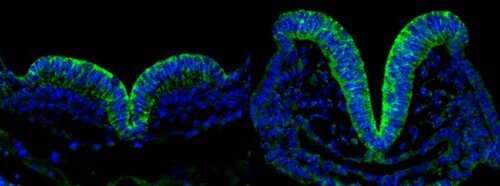Mothers’ diabetes may induce premature aging of neural tissue in early development of fetuses, leading to birth defects

More than 3 million women of birthing age in the U.S. and 60 million in the world have diabetes—a disease that occurs when blood sugar is too high. Even when controlled with insulin, and blood sugar levels are kept mostly in check, maternal diabetes can cause permanent damage to the fetus. About 300,000 to 400,000 fetuses per year from mothers with diabetes develop neural tube defects—when the tissue that eventually forms the brain and spinal cord fails to form properly—which can lead to miscarriage or profound disability.
Now using studies in mice, University of Maryland School of Medicine (UMSOM) researchers have identified the mechanism behind these structural birth defects, which they say is due to the neural tissue aging prematurely, halting its growth before it has made enough cells to finish forming the neural tube.
The study, published on June 30 in Science Advances, was conducted by the UMSOM Center for Birth Defects Research, led by Peixin Yang, Ph.D., Professor of Obstetrics, Gynecology and Reproductive Sciences, Director of the Center for Birth Defects Research, and Vice Chair of Research in the Department, and E. Albert Reece, MD, Ph.D., MBA, Executive Vice President for Medical Affairs, UM Baltimore, and the John Z. and Akiko K. Bowers Distinguished Professor and Dean of UMSOM.
“Although diabetes is a disease generally associated with an older population, the modern diabetes epidemic in young people is largely fueled by obesity and inactivity. At the same time, many aging-related diseases are impacted by diabetes, and we now know that high blood glucose seems to induce or enhance premature embryonic aging,” said Dr. Yang. “For many decades, our hypothesis was that premature aging, known as senescence, was occurring in the fetuses of mothers with diabetes, and was, in part, inducing these birth defects. It was only recently that we have had the tools and technology to be able to test our hypothesis.”
Finding the precise mechanism for how maternal diabetes leads to these and other kinds of birth defects in the fetus is the first step to identifying a way to prevent these abnormalities from occurring. In the study, the researchers were able to delay the aging process in the tissue by using a cancer drug, allowing the neural tube to fully form in mouse pups born from mice with mutations mimicking diabetes.
Their findings suggest that more specialized therapies could be developed to prevent miscarriages or birth defects in babies born from mothers with diabetes.
First, the research team showed that the neural tube tissue in 8-day old mouse pups from mothers with diabetes contained markers of premature aging. These markers were not found in pups from mothers that did not have diabetes. Researchers then found that the cells with premature aging markers secreted a flurry of other chemical signals that caused the neighboring cells to die.
Next, the researchers treated the mouse pups from mothers with diabetes with the cancer drug rapamycin, known to prevent the toxic chemical signals from being released by the prematurely aging cells. They found that mouse pups treated with rapamycin had neural tubes that were fully formed like those found in pups born from mothers without diabetes.
“This drug essentially made the senescent cells behave normally,” said Dr. Yang. Unfortunately, rapamycin affects too many other cell processes and can be toxic, so it would not be a viable treatment for preventing neural tube defects in human infants.
“Our next step is to see if birth defects of the heart and kidney found in fetuses born from mothers with diabetes are caused by the same senescence mechanism. If so, it would suggest that we can develop a single treatment more specialized to these developmental processes to prevent this spectrum of birth defects,” said Dean Reece. “As mothers with diabetes have children with five times the birth defect rate compared to the general population and incidence of diabetes is ever increasing, it is imperative that we develop ways to prevent disability and promote healthy births.”
Source: Read Full Article


